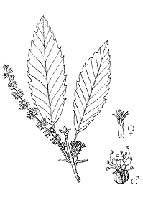


Castanea sativa Mill.
The chestnut (Castanea sativa Mill.) is a majestic tree noted among other species for its intense cultivation outside its original habitat in S.E. Europe and Asia Minor.
Some millenary examples of this species have become famous, such as the “Chestnut of the 100 horses” on the side of Mount Etna. This tree's amazing size would apparently offer 100 horsemen protection under its crown.
During Imperial Roman times cultivation of the chestnut increased greatly both as a complementary cultivated species to the vine and for the typical practice of coppicing known as ‘silva palarisa'. During medieval times in Tuscany monks intensively cultivated the chestnut tree.
The chestnut is a tree of notable longevity with an erect trunk and widely-spreading dense crown; it is typically mesophyllic in character both with regard to temperature and humidity and is sensitive to late frosts.
The main forms of cultivation of the tree are coppicing and chestnut woods cultivated for the nuts. High chestnut forests are less common and usually derive from converting coppices into tall forest.
In coppices, many trunks grow from the cut base of the tree. Usually this type of wood is periodically cut with short intervals (10 years) allowing for an assortment of small wood of small dimensions, (paleria or wood for posts). Longer intervals (20-25 years) produce large, good quality trunks (antenneta).
The typical chestnut wood cultivated for its nuts is made up of great trees (100-200 per hectare), many of which are centuries old and sparsely grown to maximize nut production

Since the Second World War the national heritage of chestnut trees has undergone a considerable reduction due to an abandonment of the cultivation of the fruit and also the attacks on the health of the trees by two pathogenic fungi which have caused severe damage to this type of vegetation. To be precise, the first disease (mal dell'inchiostro or ink disease') derives its name from the blue-black colour that the diseased trunks and roots assume, (caused by the fungus Phytophtora cambivora Petri). The second type is a ‘cortical cancer' caused by another fungus (Endothia parasitica Murr.And), which attacks the bark.
The production of edible fruit rich in starches still had a fundamental importance at the beginning of the 1900's; some chestnut woods in fact produced sufficient fruit to supply a family's food requirements for the whole of the winter.
The name ‘marron' refers to particularly prized chestnuts characterized by nuts producing a single kernel of excellent perfume and flavour and nutshells which are easy to peel.
Chestnut leaves are about 10-12 cm long and 4-8cm wide, oval, pointed, with toothed margins, and well-defined lateral venation.

The decomposed fallen leaves help to form humus, a rich top layer of organic material over the soil.
The role of grafting in regenerating and improving chestnut woods.
The current situation and future prospective for chestnut woods is tied to the cultivation of the varieties producing the most select nuts; particularly the various types of marron. For this reason different methods of grafting onto rootstocks have assumed considerable importance as a means of regenerating and improving the variety of chestnut trees in the woods. In the grafting process a scion of one variety is grafted onto a rootstock of another.
The first phase takes place in March and consists in collecting material from the most healthy and vigorous trees from which smaller scions are later cut. This material is kept refrigerated for the necessary length of time and is then ready for use. The next step is to select in advance the chestnut shoots from the rootstock most suitable for use in grafting and cut them diagonally at a height of 1m – 1.30m from the ground. The most suitable method for grafting is then applied. The principal techniques for chestnut grafting are those called cleft-grafting with the scion cut in a wedge-shape and then placed in the cleft of the host branch; and crown grafting which is carried out in May where the scions are cut in an asymmetrical wedge-shape then introduced between the bark and the wood of the host. Good results are obtained by grafting in favourable weather conditions and with the aid of special sharp tools, the open cuts protected by a layer of wax.
